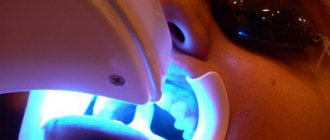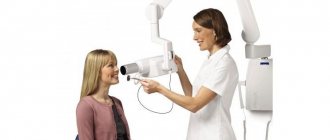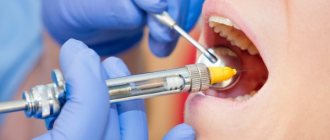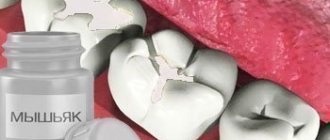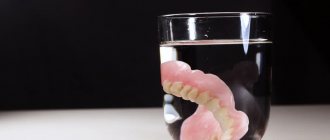A dental x-ray is a detailed image of the teeth, bones and soft tissues around them, allowing us to identify various dental and oral problems. X-rays can show cavities, hidden dental structures (such as wisdom teeth), bone loss and other abnormalities that cannot be detected during a visual examination and a routine dental consultation. Dental X-rays are usually performed annually. It is also actively used for follow-up monitoring of teeth after treatment. X-rays may be prescribed more often if your doctor monitors the development of a dental problem directly during treatment.
Types of dental x-rays
Today, there are four main types of dental x-rays according to their intended purpose:
- Bite X-ray – an image of the upper and lower rows of teeth in a closed state. This type of x-ray helps identify malocclusions, subsidence of bones, interdental caries, and the presence of hidden cavities. Also allows visualization of bone loss due to severe gum disease or dental infection.
- A peripheral x-ray of a tooth depicts the entire tooth, its surface and internal parts, that is, it is an image from the crown of the tooth to the part of the bone that supports it. These x-rays are used to identify dental problems below the gum or jaw line, such as affected teeth, abscesses, cysts, tumors, and bone changes associated with certain diseases.
- An occlusal photograph is aimed at identifying the condition of the roots of the teeth and the dental floor. It is actively used for jaw fractures, cleft palate symptoms, abscesses and suspected presence of hidden/not yet erupted teeth (including wisdom teeth). Occlusal x-rays can also be used to detect foreign objects.
- Panoramic x-ray of teeth. Allows you to obtain a detailed image of the jaws, teeth, nasal cavity and jaw joints. This type of x-ray does not allow visualization of cavities. This type of x-ray is effective in diagnosing tooth fractures, various bone pathologies, cysts and neoplasms. Actively used before orthodontic treatment.
Types of X-ray machine for a dental clinic
Where should you start when choosing a dental x-ray unit? We recommend asking yourself a few questions, the answers to which will become the determining individual criteria for your future device.
- What budget are you looking for?
- Do you need additional functionality of the device or are the standard functions sufficient?
- What operating conditions are planned for your clinic?
- Are X-ray diagnostics planned to go to patients’ homes?
- How often is it planned and is it even planned to transport the device around the clinic?
As soon as the answers to these questions are ready, you can move on to a more detailed study of possible dental X-ray machines.
1. Stationary X-ray machines
- equipment that is intended exclusively for work in one limited space (X-ray room).
2. Mobile X-rays
— this type of device is often used in hospital settings, where regular movement of equipment is necessary. It is convenient to move such equipment across floors, to transport it directly to the bedside of a seriously ill patient, and comfort for nurses or doctors who work with transporting this type of X-ray is ensured by a reliable vertical stand with comfortable wheels and automatic brakes.
In addition to using such mobile equipment in a hospital setting, it does its job well in the field. X-ray machines with a mobile mechanism easily fit into the car.
3. Portable X-rays
— devices are comfortable, small-sized equipment that allows you to perform diagnostics at a high professional level without interrupting your work. This device is especially relevant for seriously ill people, as well as for people with limited mobility. The compact device is light in weight and can significantly reduce the time spent moving patients to the X-ray room and waiting for images to be developed.
You should choose one or another type of device based on the planned placement and purpose of use. Thus, the purchase of mobile units would be appropriate for wards in hospitals, since they are fully adapted to these functional conditions. Another important point will be the choice of equipment power.
Important! The power depends on the type of device and its manufacturer. The average power of mobile X-ray equipment is 13.0 -32 kW. A stationary X-ray machine has a minimum power of 40 kW.
The X-ray unit itself should be selected taking into account the goals, capabilities and conditions of the dental clinic.
What can an x-ray reveal?
Thus, using dental x-rays, the dentist can determine:
- inflammatory processes inside the tooth that are invisible during normal examination;
- presence, size and location of neoplasms (eg, cysts) or foreign bodies;
- quality of dental canal filling;
- the degree of development of caries and the presence of deep, hidden carious areas;
- the presence of an abscess or other purulent-inflammatory processes;
- cracks in teeth;
- abnormalities in bone development;
- the presence of hidden, unerupted teeth (for example, wisdom teeth).
The most popular models of targeted X-rays
Rextar
Dental X-ray machine Rextar - X (RT-1010 / Rextar LCD) from the South Korean brand Poskom is a model of a portable high-frequency device.
High-precision, ergonomic Rextar-X always guarantees:
- ideal image quality due to the generated radiation;
- ideal protection from radiation (even in minimal doses) thanks to the lead plates from which the device body is made;
- no need to use additional protection;
- the ability to take pictures taking into account the correct exposure;
- bright lighting - the presence of an LED display greatly facilitates the work process;
- the ability to work while simultaneously holding the device in your hands, since the weight and size of the device are minimal - which means that the dentist will not need an assistant.
Lightweight, high-precision, convenient and safe X-ray machine Rextar - X, which, among other things, can be equipped with a tripod and control panel.
Rextar is one of the most practical and convenient modern models of portable X-ray machines for dentistry!
Targeted dental images using Rextar-X are distinguished by the highest resolution, which always contributes to an accurate result and a favorable treatment outcome.
The conclusion is obvious: dental X-rays using Rextar - X are the most reliable way to quickly and accurately diagnose teeth and the oral cavity.
How much does Rextar cost - X
The price of Rextar - X is slightly different from the prices of other models of portable X-ray machines. And naturally, the question arises: is it worth overpaying?
If you want to buy an X-ray machine for daily use, and expect 100% return: reliability, speed, high quality panoramic images, guaranteed service life and other objective advantages of a modern high-quality X-ray machine, then you are unlikely to be confused by the price , which pays for itself in a matter of months.
How to quickly and efficiently take a targeted photograph of a tooth using other X-ray machines, how much do they cost and which X-ray diagnostic device in dentistry is next to Rextar - X?
PROX
PROX is a portable X-ray machine from DigiMed (Korea), highly technical, compact, and ergonomic.
The PROX X-ray machine is designed for dentists and dental technicians to use as an extraoral source of X-ray radiation. PROX provides excellent diagnostic and x-ray imaging with both intraoral image receivers and film. PROX is used in the diagnosis of adults and children.
The advantages of PROX also include low weight and size, complementability with a tripod, wall arm and control panel.
FONA XDG, X70, XDC
Italian X-ray machines FONA are another series of high-tech equipment for dentistry, thanks to which precise images are obtained that satisfy the rather strict approach of specialists to quality.
Dental X-rays with the FONA XDG, a wall-mounted or stand-mounted unit, involve not only the use of high-resolution digital image receivers, but also fine-grained films.
FONA X70 and FONA XDC are classic X-ray machines designed to resolve always pressing issues in dentistry. Work with conventional X-ray films and digital sensors. FONA X-rays are available on the wall or on a stand.
Features of the appointment of dental x-rays
If you are a new patient, you will likely undergo dental x-rays so that the new dentist can get a clear picture of your dental health. This is especially important if you do not have x-rays from your previous dentist. Children may need dental x-rays more often than adults because their dentists need to monitor the growth and development of their teeth. This is important because it can help the dentist determine whether baby teeth need to be removed to prevent complications, such as adult teeth growing behind baby teeth.
Service and repair of dental x-ray equipment and equipment
Dental x-ray equipment
, regardless of cost, wears out over the course of its service life, requires maintenance or fails.
If malfunctions or signs of malfunctions or deviations from the norm are detected, it is necessary to apply for diagnostics and repair of X-ray equipment in a timely manner in order to resolve the problems in the shortest possible time in order to avoid situations that may endanger the health of patients and doctors.
The service package for equipment maintenance must be regular.
The frequency of service work is established by the relevant documentation and depends on the manufacturer’s recommendations and on the exhaustion of the equipment’s service life.
Risks of Dental X-Rays
Dental X-rays involve radiation, however, the radiation levels are so low that it is considered safe for both children and adults. If your dentist uses digital X-rays instead of film X-rays, the risks from radiation exposure will be even lower.
Also, before the x-ray, the specialist will provide you with a protective apron to put on your chest, abdomen and pelvic area to prevent unnecessary radiation exposure to vital organs. In case of thyroid disease, a special thyroid collar may be used. Children and women of childbearing age may also wear it along with a lead bib.
Pregnancy is a contraindication for radiography. Women who are pregnant or think they may be pregnant should avoid all types of X-rays. Tell your dentist if you think you are pregnant because radiation exposure is not considered safe for the developing fetus.
Equipment service
The set of measures to restore medical devices and keep them in good condition depends on the type of equipment; therefore, service is individual for each type of X-ray equipment.
Service activities include technical work, which includes:
- Commissioning.
- Checking and monitoring technical condition.
- Planned and routine maintenance.
- Current repair or restoration.
All X-ray equipment must undergo a post-repair inspection, which is regulated by the operating instructions.
Qualified specialists of our company are ready to provide service for your clinic’s dental equipment.
Preparation and carrying out the procedure
Dental X-rays do not require special preparation. The specialist will guide you through each step of the x-ray process. He may leave the room briefly during filming. You will be required to stand or sit still for short periods of time. Spacers (film holders), if used, will move and adjust in the mouth to produce correct images.
Once the images are ready—immediately in the case of digital x-rays—your dentist will check them and determine whether or not there are any abnormalities.
Devices and installations for radiography in dentistry
The best and most convenient X-rays today are portable dental devices from the companies Poskom, DigiMed (South Korea) and SwiDella (China), as well as FONA (Italy) - a wall-mounted or mobile X-ray unit on a stand.
Each model is an example of an innovative approach to the development and production of dental equipment that meets international quality standards.
Simplicity, safety and ease of use are the obvious advantages of portable X-rays from Poskom, DigiMed, FONA XDG, SwiDella, which are guaranteed to improve the quality of a specialist’s work.
Digital radiography
Today there is a new technique for dental radiography using digital technology. The new method eliminates the need to develop X-ray film in a dark room; instead, the X-rays are sent directly to a computer and can be viewed on screen, saved or printed. There are several advantages of using this technology:
- minimal radiation;
- saving time - the image is available on the screen a few seconds after shooting is completed;
- the ability to enlarge images multiple times compared to their actual size on the computer screen;
- the ability to send images by email (for example, to another specialist to get a second opinion, etc.);
- software installed on a computer can help dentists digitally compare current images with previous ones in the process of subtraction radiography. Using this technique, everything that is similar between two images is "subtracted" from them, leaving a clear, detailed image of only the part that is different. This helps dentists easily see subtle changes that might not be immediately noticeable.
Dental radiography is of fundamental importance for correct diagnosis. Thus, today radiography is an integral and extremely important part of professional dental care.
Dental X-ray machines
A dental x-ray machine is a device necessary for high-precision diagnostics and successful therapeutic and surgical treatment. This is the only way to obtain the most reliable information about the condition of the patient’s teeth and jaws.
Modern dental X-rays provide superior image quality with significantly less radiation exposure to the patient, regardless of the type of image recorder.
By type of image recorder there are:
- Film systems. They are gradually becoming a thing of the past, because Although they form a high-quality image, they create a large radiation load on the patient and staff and require time to form the image.
- Digital X-ray systems – visiographs. The most modern method of obtaining images in dentistry. Thanks to the high sensitivity of the sensors, it significantly reduces the radiation dose, allows the specialist to be close to the patient, and the image is formed instantly. Modern visiographs provide image quality of more than 25 pairs of lines.
There are also systems that can work with both film and a visual imager (if the settings are changed).
A separate line worth highlighting is portable digital X-rays - compact devices similar in size to a camera, allowing you to take pictures directly at your workplace.
Choosing a Dental X-ray
When choosing a modern dental X-ray machine, you should immediately pay attention to models designed to work with a visiograph (appropriate radiation parameters, exposure time, the ability to synchronize with a visiograph and a computer). The best choice is an x-ray and a visiograph from one manufacturer. This will ensure maximum compatibility and, consequently, efficiency of the equipment.
It is worth carefully reading the requirements for the equipment of dental X-ray rooms specified in SanPiN 2.6.1.802−99. Devices that work with visiographs, subject to certain requirements, can be placed directly in the treatment room. Powerful devices designed only for working with film require placement in a separate, specially equipped room.
Please note that X-ray machines are large consumers of electricity and create significant peak loads on the network. In this regard, it is recommended to use powerful (up to 3 kW) voltage stabilizers with a high response speed.
It would seem an insignificant, but very important aspect - to purchase dental x-rays and visiographs from the same supplier or from different ones? TIARA-MEDICAL specialists recommend purchasing equipment from one supplier. Firstly, this will eliminate the option of choosing incompatible or partially compatible equipment. Secondly, service and warranty services will be carried out by one company, which is faster and more convenient than coordinating the work of different specialists.


